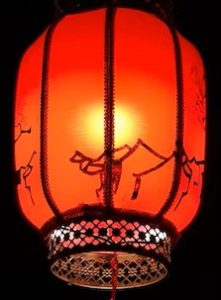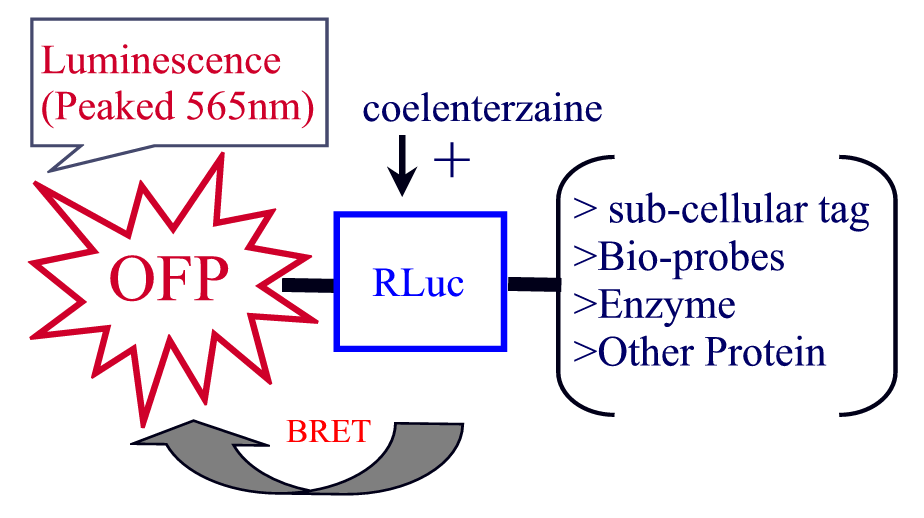Nano-Lantern Imaging
 1 Why use Nano-Lantern?
1 Why use Nano-Lantern?
Fluorescent-markers and bioluminescence are two of the most commonly used methods for in vivo imaging in living cells.
Fluorescence imaging is an extremely valuable tool; however, it requires external excitation from a laser light. This laser light can have drawbacks such as autofluorescence, phototoxicity, and photobleaching. On the other hand, bioluminescence imaging does not require light activation but suffers from low brightness. It is very dim and typically requires long exposure times, making it impossible to observe small, rapidly moving structures.
To overcome these barriers, an enhanced bioluminescence imaging method called Nano-Lantern was developed [1]. This method uses a bioluminescence resonance energy transfer (BRET) approach to enhance the signal intensity of bioluminescence imaging. When the substrate of Renilla luciferase (coelenterazine) is added, it utilizes energy transfer between fluorescent protein (FP) and luciferase to produce stronger bioluminescence images. see scheme below:

Nano-Lantern is bright enough to image sub-cellular structures and can even detect single molecules. It has an extremely low-level background signal, making it more sensitive and quantitative. When linked to a targeting protein, Nano-Lantern emits light in response to specific biological activity, making it a great tool for visualizing specific biological activity In vivo in real-time.
2. Gentarget’s Nano-Lantern Bio-probes:
GenTarget has utilized its proprietary lentiviral vector systems to generate a set of Orange Nano-Lantern Lentivirus products for In Vivo luminescence Imaging Applications. These Lentivirus products connect a well-defined organelle targeting structure or a Bio-probe to the specially designed Orange-Nano-Lantern structure. This Nano-Lantern consists of an enhanced Renilla-Luciferase connected to an Orange Fluorescent Protein (OFP). see the Lentivector’s Scheme below:

The specially designed Nano-Lanterns emit light in response to specific biological activities (such as Ca++ dynamics) or for In Vivo luminescence imaging of sub-cellular structures. Please select different products below. And Click to see details in Product Manual (pdf).
References:
| Name | SKU | Price | Buy |
|---|---|---|---|
| Nano-Lantern Cytoplasm area | LVP1532 | $695.00 | |
| Nano-Lantern Cytoplasmic NAD+ Bioprobe | LVP1524 | $695.00 | |
| Nano-Lantern Endoplasmic Reticulum | LVP1533 | $695.00 | |
| Nano-Lantern Endosomes | LVP1539 | $695.00 | |
| Nano-Lantern Golgi | LVP1534 | $695.00 | |
| Nano-Lantern H2B | LVP1530 | $695.00 | |
| Nano-Lantern hTERT | LVP1529 | $695.00 | |
| Nano-Lantern Lysosomes | LVP1538 | $695.00 | |
| Nano-Lantern Microtubule | LVP1537 | $695.00 | |
| Nano-Lantern Mitochondria | LVP1535 | $695.00 | |
| Nano-Lantern Mitochondrial NAD+ Bioprobe | LVP1522 | $695.00 | |
| Nano-Lantern Nuclear Ca++ Bioprobe | LVP1454 | $695.00 | |
| Nano-Lantern Nuclear Cas9 Probe | LVP1525 | $695.00 | |
| Nano-Lantern Nuclear dCas9 Probe | LVP1526 | $695.00 | |
| Nano-Lantern nuclear membrane | LVP1536 | $695.00 | |
| Nano-Lantern Nuclear NAD+ Bioprobe | LVP1523 | $695.00 | |
| Nano-Lantern Nucleus area | LVP1531 | $695.00 | |
| Nano-Lantern plasma membrane | LVP1540 | $695.00 | |
| Nano-Lantern Zyxin | LVP1527 | $695.00 | |
| Nano-Lantern β-tubulin | LVP1528 | $695.00 | |